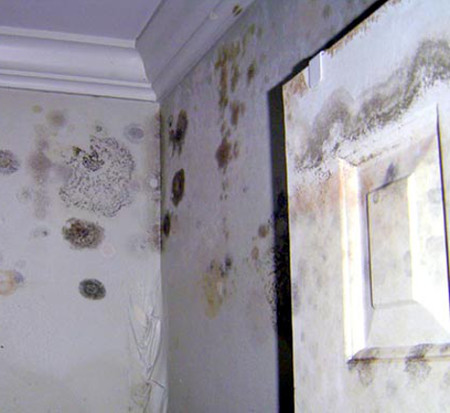About house mold

Molds are a types of fungi (just like mushrooms), that are found outside in our natural environment. Molds that are found outside is in fact helpful as it recycles and decomposes biological matter, that if left can drown humanity in the waste that it produces.
All molds need to thrive is a little moisture. They like warm, moist environments, which has some organic matter that they can feed on. They get enough of this outside or in damp places. It grows from spores (its reproductive cells), which floats around in the air. If it drops on a favorable place, it starts growing there. If this spore drops in a favorable moist place inside the house and starts growing, it creates such an unsightly stain as it can grow on shoes, bags, clothes, books, etc. mold stains materials badly and can eat into surfaces.
Apart from material damages, molds adversely affects our health. According to the Environmental Protection Agency (EPA), all molds have the potential to cause ill health. It is generally problematic to everyone at all ages. It causes asthmatic attack and allergic reactions from people, as well as coughing and wheezing. This allergy is due to exposure to mold. It develops tiny spores that irritates the respiratory system. It can get as bad as infecting the sinuses that grows within the nose and might need a surgical procedure to remove it.
How to prevent mold
Mold needs moisture, warmth, spores and nutrients to thrive. Of all the needs moisture is the easiest to control. Therefore, the key to preventing the formation of mold is by preventing moisture build-up in any part of the house. Building a good ventilation in our homes is the best way of preventing moisture build-up. This way, air is continuously in circulation, no chance for it to stagnate and build-up moisture. Get a quality air purifier to control mold and detoxify air supply of mold spores. Discard any material that is too infected with mold. Isolate it and destroy it to avoid infecting others as molds spreads easily from the infected to others.
Places to take special care to prevent mold growth includes:
- In the kitchen, under the sink, cupboard and under dish racks,
-
In the bathroom,
-
In the basement,
-
Roof area, where there is a leak,
-
Under or beside refrigerators, dishwashers or washing machines.
- Anywhere that water remains for long periods of time.
The signal of mold is a musty odor. Look around wherever you perceive this mildew-like smell. Check properly and see where they are forming and remove the growth.
Removing molds
Most of the time, mold can be easily removed from hard, non-porous surfaces by simply scrubbing with a stiff bristle brush and the cleaning solution of your choice. It is when it grows on porous surfaces that it becomes a little more challenging. If you notice the mold developing in these places at your home, the best-recommended solution is of two steps.
Physically remove the mold:
Scrape or scrub the mold off of the surface with a scraper or stiff bristle brush. Vacuum up the mold. Do this with a vacuum that is equipped with a good HEPA filter, or else you could just be spreading the mold into the air.
Treat the surface:
Once you have removed the mold growth above the surface, you will need to address the roots. There are a few natural products that can be used effectively to treat the roots left behind on porous surfaces. For this article, we will cover use of Borax to treat mold growth.
How to use Borax and water to treat mold growth on porous surfaces:
Borax is an amazing product for green cleaning. It is made from sodium borate, a very effective anti-fungal. It can be used for your regular household cleaning as well as to fight off mold growth on porous and non-porous surfaces. It occurs naturally in dry lake beds and deserts which makes it perfect for green cleaning. Here is how you can use it to clean up mold.
The recipe for mold removal is: 1 cup of borax to one gallon of hot water. Mix this solution well and pour into a pump sprayer. Spray the surface liberally with the solution. You don't need to wash the spray off, as it will continue to treat the area and prevent future mold growth.
Mold remediation is serious business. It can be dangerous to your health if not done properly. It's also important to follow the US EPA guidelines for mold removal if the affected area is large enough to cause cross contamination. Please click this link to find out more about mold remediation in your home.